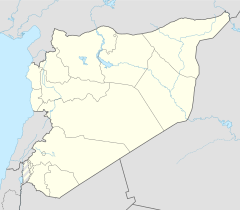| Qasr al-Hayr al-Sharqi قصر الحير الشرقي | |
|---|---|
 Panoramic view of Qasr al-Hayr al-Sharqi | |
| General information | |
| Town or city | Homs Governorate |
| Country | Syria |
| Coordinates | 35°04′26″N 39°04′16″E / 35.073889°N 39.071111°E |
| Technical details | |
| Material | adobe |
Qasr al-Hayr al-Sharqi (Arabic: قصر الحير الشرقي, lit. 'Eastern al-Hayr Palace or the "Eastern Castle"') is a castle (qasr) in the middle of the Syrian Desert. It was built by the Umayyad caliph Hisham ibn Abd al-Malik in 728-29 CE in an area rich in desert fauna.[1] It was apparently used as a military and hunting outpost.[2] The palace is the counterpart of Qasr al-Hayr al-Gharbi, a nearby castle palace built one year earlier.[1] It is one of the so-called desert castles.
YouTube Encyclopedic
-
1/4Views:3253621 67010 739
-
FAST Lecture: Archaeological Photography at Qasr al-Hayr al-Sharqi
-
#105 Qasr Al Hayr Al Gharbi (English Subtitle)
-
Inside Syrian Idlib: Maarat al Numan
-
Pressing questions that make Muslims leave Islam
Transcription
Location
Qasr al-Hayr al-Sharq is 28 kilometres (17 mi) from Al-Sukhnah and 100 kilometres (62 mi) from Sergiopolis (Rusafa), near Bishri Mountain near Palmyran Middle Mountains.
Syrian Civil War
During Syria Civil War, Qasr al-Hayr al-Sharqi was captured by armed groups in 2013, then by ISIS. The Castle have been damaged by looting and vandalism. The visitor house has been burgled.[3] The Syrian Army recaptured the castle on 22 August 2017.[4]
Architecture
Like other Umayyad architectural works, the construction style was influenced by Byzantine and Sasanian architectures.[5]
The palace consists of a large open courtyard surrounded by thick bulwarks and towers guarding the entrances and each corner.[6] The ruins consist of three main components, known as the Small Enclosure, the Large Enclosure and the Outer Enclosure, each of which differ in form and function.[7] The palace(s) contains remnants of rooms, arches and columns which seem to be parts of a huge royal complex, including smaller structures, a reception hall, a mosque, a large bathhouse, gardens, courtyards and a complex water control system. Believed to each be made of a fine-grained limestone with an amber tint, these structures are each complex and visually stunning. In addition to the using stone, these towers exhibit a unique and charming decorative design, using brick and stucco.[8] The bigger palace has been several floors, with a huge gate and many towers. Towers were not built as defensive measures. There were also olive yards. The palaces were supplied with water by nearby Byzantine church by a canal 5,700 metres (6,200 yd) long.
Qasr al-Hayr al-Sharqi was ultimately abandoned at the start of the fourteenth century, resulting in an unprecedented opportunity to study urban life, order and planning during the early Islamic period.[8] The site was excavated in six seasons between 1964 and 1971 by renowned Islamic art historian Oleg Grabar.[9][10] Excavation of this site provided a unique example for historians and archaeologists of the ecological developments and decorative elements and materials of the area, such as ceramics and coins.[8] Some of the decorated parts have been moved to the National Museum of Damascus while the gate has been reconstructed in the Deir ez-Zor Museum.[11]
World Heritage Status
This site was added to the UNESCO World Heritage Tentative List on June 8, 1999, in the Cultural category.[12]
Gallery
-
Walls and towers
-
Walls and towers
-
Byzantine arches and columns
-
See also
Notes
- ^ a b Constable, O.R. (2003). Housing the Stranger in the Mediterranean World: Lodging, Trade, and Travel in Late Antiquity and the Middle Ages. Cambridge: Cambridge University Press. p. 56. ISBN 0-521-81918-0.
- ^ Un Château du désert: Qasr al-Hayr ach-Charqi - UNESCO World Heritage Centre Archived February 13, 2009, at the Wayback Machine.
- ^ A desert Castle: Qasr al-Hayr ach-Charqi (UNESCO)
- ^ @watanisy (22 August 2017). "tigers captured Qasr al-Hayr al-Sharqi" (Tweet) – via Twitter.
- ^ Arce, Ignacio. "UMAYYAD BUILDING TECHNIQUES AND THE MERGING OF ROMAN-BYZANTINE AND PARTHO-SASSANIAN TRADITIONS: CONTINUITY AND CHANGE". Late Antique Archaeology. Retrieved 4 April 2019.
- ^ Un Château du désert : Qasr al-Hayr ach-Charqi - UNESCO World Heritage Centre Archived February 13, 2009, at the Wayback Machine
- ^ Genequand, Denis (2005). "From 'desert castle' to medieval town: Qasr al-Hayr al-Sharqi (Syria)". Antiquity. 79: 350–361.
- ^ a b c Holod-Tretiak, Renata (1970). "Qasr al-Hayr al-Sharqi: A Mediaeval Town in Syria". Archaeology. 23 (3): 221–231.
- ^ Grabar, Oleg; Renata, Holod; Knustad, James; Trousdale, William (1978). City in the Desert, Qasr al-Hayr East. Boston: Harvard University Press.
- ^ Gruber, Christiane; Al-Ferzly, Michelle; Holod, Renata (2021). City in the desert, revisited: Oleg Grabar at Qasr al-Hayr al-Sharqi, 1964-71. Kelsey Museum publication. Ann Arbor, Michigan: Kelsey Museum of Archaeology. ISBN 978-1-7330504-0-1.
- ^ Bonatz, Dominik; Kühne, Hartmut; Mahmoud, As'ad (1998). Rivers and steppes. Cultural heritage and environment of the Syrian Jezireh. Catalogue to the Museum of Deir ez-Zor. Damascus: Ministry of Culture. OCLC 638775287.
- ^ "Un Château du désert: Qasr al-Hayr ach-Charqi - UNESCO World Heritage Centre". Archived from the original on 13 February 2009. Retrieved 4 March 2009.
35°4′26″N 39°4′16″E / 35.07389°N 39.07111°E







